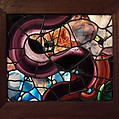Window
Louis C. Tiffany American
Not on view
Louis Comfort Tiffany (1848-1933) was one of the most celebrated artists at the turn of the twentieth century. Throughout a career that spanned the 1870s through the 1920s, his work included painting and almost every decorative art medium. His travels abroad encouraged his interest in art from the Near and Far East, which informed his decorative work alongside those inspired by nature. Simultaneously, he embodied modernity, affording him wide-ranging acclaim. Tiffany is best known for his leaded-glass windows; this example is unique among his works in glass. Contemporary viewers would have been startled by its forward-thinking abstraction and the marbleized effects of the glass, which show the beginnings of his experiments with the material. The design, in light-filled saturated colors, seems as though it were created by broad strokes of a painter’s brush. In the upper right corner, opaque white glass with embedded flecks of color is a precursor to Tiffany’s “confetti” glass of later years, while rough-cut chunks of glass “jewels” give the window a three-dimensionality. This window is the designer’s earliest known domestic window, and was installed in his own New York apartment. The Deedee Wigmore Gallery (743) features a permanent display devoted to the work of Louis Comfort Tiffany in many media.
Due to rights restrictions, this image cannot be enlarged, viewed at full screen, or downloaded.
This artwork is meant to be viewed from right to left. Scroll left to view more.



